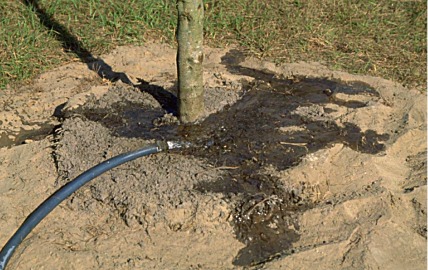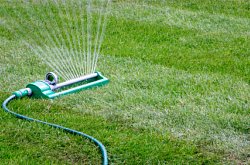Proper watering can make the difference between life and death to newly planted lawns, trees, shrubs, bedding plants, vegetable transplants and ground covers during the summer.
Because their roots have not had time to grow out into the surrounding soil, these plants do not yet have well-established root systems. With their root systems still limited to a relatively small area of soil, they are especially vulnerable to drought stress.
Trees
 The first summer after planting is the most critical time for newly planted trees, and proper watering plays a major role in whether or not they survive – or how well they survive. Here are some effective watering techniques for trees.
The first summer after planting is the most critical time for newly planted trees, and proper watering plays a major role in whether or not they survive – or how well they survive. Here are some effective watering techniques for trees.
One good method is to turn a hose on trickle, lay the end on top of the ground within 6 inches of the trunk of the tree and let the water trickle for about 20 minutes to 30 minutes. Or build a 4-inch high levee out of soil around the edge of the area dug up to plant the tree. Fill this area with water and let it slowly seep into the root zone.
I’ve found one of the best methods is to use a heated metal skewer or ice pick to pierce five to 10 holes through the bottom of a 5-gallon paint bucket or similar container. Make all the holes on one side. Place the bucket next to the tree trunk with the holes closest to the trunk. Fill up the container, and the water will slowly seep through the holes, providing excellent irrigation. If you want, you can spray paint the outside of the bucket dark green to make it less noticeable.
Use any of these techniques during hot weather whenever seven to 10 days pass without substantial rainfall. Continue to water twice a week until a good rain occurs. Drought-stressed trees may experience wilting, leaf drop, yellow or brown leaves, scorched leaf edges or even death.
Shrubs
Newly planted shrubs will need to be monitored more carefully and watered more frequently than established shrubs. Water with soaker hoses or sprinklers left on long enough for the water to penetrate at least 4 to 6 inches into the soil.
Keep in mind that all of a newly planted shrub’s roots are in a small area – about the size of the pot the shrub was growing in before planting. This is especially true for shrubs planted after March, since they have had little time to grow roots into the surrounding soil. A shrub can use up all the water in its root ball and become drought stressed even though the soil in the bed outside of the root ball is moist. So when checking the soil moisture in the bed, always be sure to stick your fingers right around the shrubs themselves.
Lawns
 Now is a great time to lay sod to install a new lawn or repair an established one. But keep in mind that newly laid sod needs special attention to watering.
Now is a great time to lay sod to install a new lawn or repair an established one. But keep in mind that newly laid sod needs special attention to watering.
Water newly laid sod for about 15 to 20 minutes every day for the first seven to 10 days. Then water for about 30 minutes every other day for another seven to 10 days. After that, irrigate the lawn thoroughly once or twice a week, as needed, to encourage the roots to grow deep into the soil.
Do not water every day for more than 10 days or you may encourage fungus diseases. And, of course, there is no need to water if adequate rainfall occurs.
Seeds
Water seeded areas (vegetable seeds, flower seeds or lawn seeds) lightly by hand or with sprinklers every day until the seeds germinate and start to grow. It is critical for the soil to stay moist during germination.
Once the seeds come up, water more thoroughly less often to encourage the roots to grow deep into the soil. As the seedlings become established, water normally as needed.
Containers
 Watering plants in containers outside is a constant job during the summer. It is typical to water every day, even twice a day, when weather is hot and dry. Keep this in mind when considering how many outside container plants you can maintain.
Watering plants in containers outside is a constant job during the summer. It is typical to water every day, even twice a day, when weather is hot and dry. Keep this in mind when considering how many outside container plants you can maintain.
How often you have to water container plants is influenced by temperature, pot size, the type of potting mix, the drought tolerance of a plant, whether a plant is in sun or shade and how pot bound a plant is. Plants need to be watered more frequently when it is hot, if the containers are small, if a light potting mix is used, when plants are in a sunny location and when plants are pot-bound. In addition, clay pots tend to dry out faster than plastic or glazed ceramic pots.
To reduce the amount of watering you have to do, use larger rather than smaller pots, choose a potting mix that retains more water (it must still be fast draining, however), repot pot-bound plants into larger containers, use plastic pots and, if practical, move the plants into somewhat shadier conditions.
Potting mixes will retain more water with the addition of hydrophilic polymers. These gelatin-like particles hold large amounts of water without creating a waterlogged soil condition. Look for these polymer products or potting mixes that contain them where garden supplies are sold.
